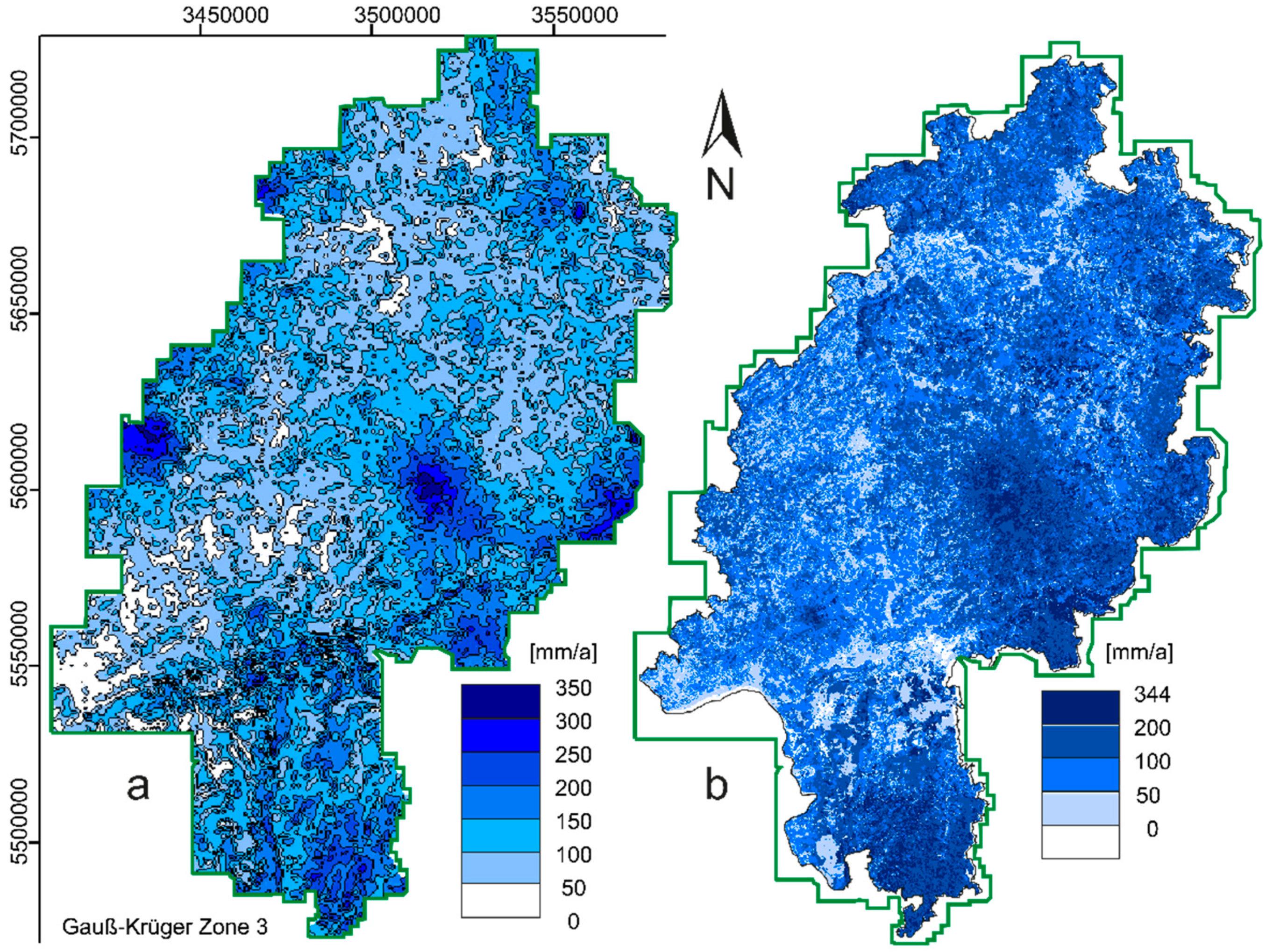The Effects of Regional Fluid Flow on Deep Temperatures (Hesse, Germany)
Abstract
1. Introduction
2. Input Data
2.1. Structural Model
2.2. Temperature Database and Previous Thermal Simulations
2.3. Hydraulic Observations and Previous Hydraulic Simulations
3. Methods
3.1. Workflow
3.2. Numerical Simulation
3.3. Properties
3.4. Thermal Boundary Conditions (BC)
3.5. Hydraulic Boundary Conditions
4. Results
4.1. Steady-State Simulations
4.1.1. Hydraulic Steady-State Simulations
4.1.2. Thermal Steady-State Conductive Simulations
4.2. Thermo-Hydraulic Steady-State Simulations
4.3. Transient Thermo-Hydraulic Simulations
4.3.1. Transient Simulations with Constant Viscosity and Density
4.3.2. Transient Simulations including Density and Viscosity Variations
5. Discussion
5.1. The Deep Thermal Field Underneath Hesse–Physical Processes and their Influence
5.2. Model Validation
5.2.1. Predicted Versus Measured Temperature Data
5.2.2. Predicted Flow Field and Hydraulic Observations
5.3. Limitations of the Current Study and Ongoing Activities
6. Conclusions
- Areas where the deep thermal field is mainly controlled by conductive heat transport are identified in North-West Hesse (Rhenish Massif), in East Hesse (Rhoen) and in South-East Hesse (Odenwald). There, measured temperatures are well reproduced assuming steady-state conductive heat transport. This implies that the distribution of heat conductivity and radiogenic heat production are well chosen in the parameterization. In these regions, the permeability is low and thus fluid flow related heat transport is negligible.
- Areas additionally influenced by pressure-driven fluid flow are North Hesse (Hessian Depression), central Hesse (Vogelsberg) and South Hesse (Eastern Graben Fault of Upper Rhine Graben). A regional flow field evolves in response to the structural and hydraulic configuration of the subsurface. At the Eastern Graben Fault, this flow field is induced by high hydraulic pressures at the Graben shoulders in concert with contrasting permeabilities, which are high in the Cenozoic sediments and low in the Variscan crust.
- Local domains are identified where density driven fluid flow can evolve and can overprint the effects of conductive and advective heat transport in the Cenozoic sediments of the Upper Rhine Graben. In these areas, a sufficiently thick permeable unit provides the conditions for buoyancy-driven fluid flow and thus free convective heat transport.
- Building on this regional differentiation of domains controlled by different heat transport mechanisms, future work should focus on the domains of pressure driven and free convection. Local higher resolved models, taking e.g., faults and facies dependent parameterization into account, could address the prediction of exact temperatures and flow conditions.
Supplementary Materials
Author Contributions
Funding
Acknowledgments
Conflicts of Interest
Appendix A. Temperature Database Consisting of Measured Temperatures
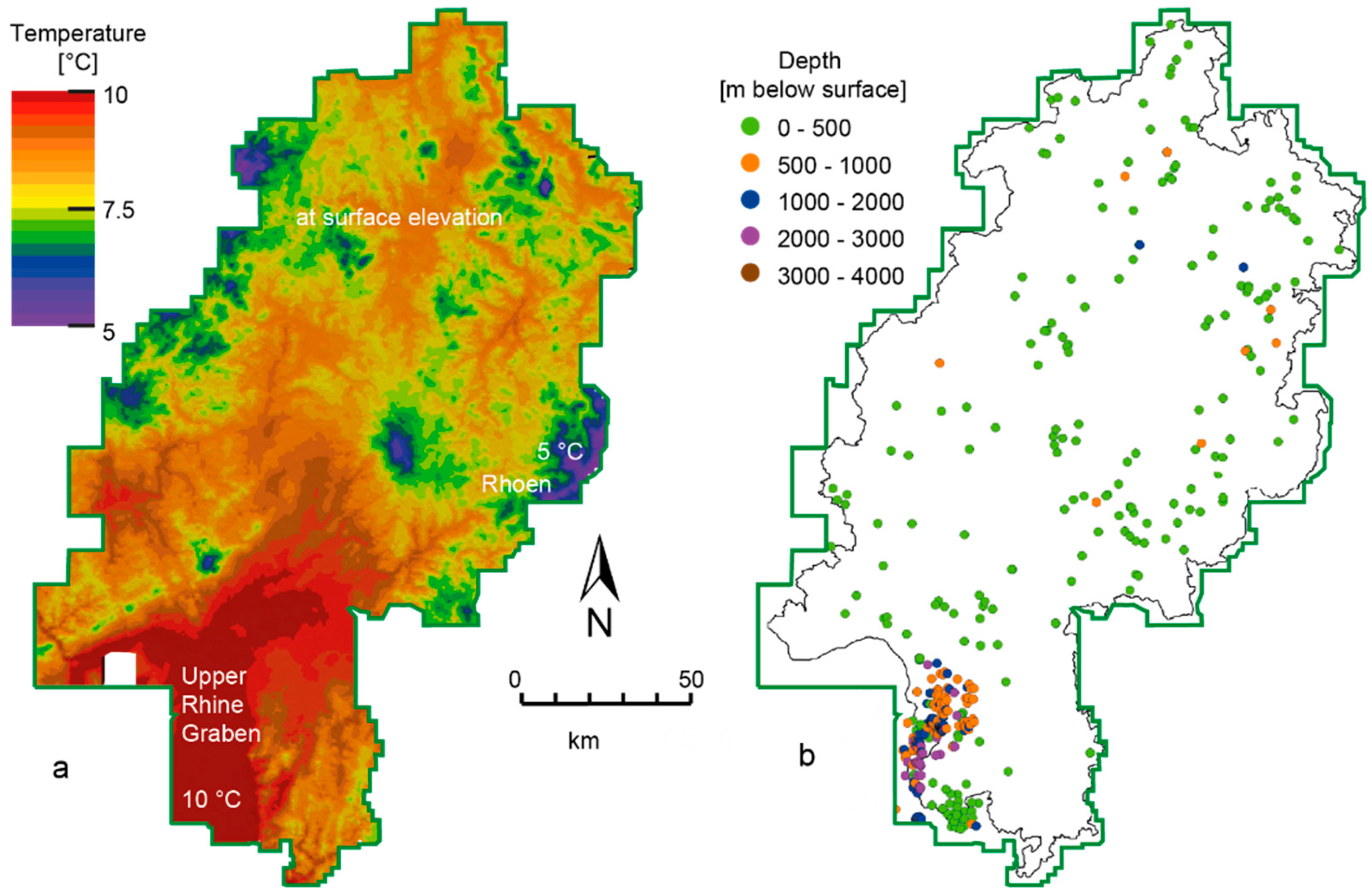
Appendix B. Hydraulic and Hydrochemical Datasets
Appendix B.1. Hydraulic Database
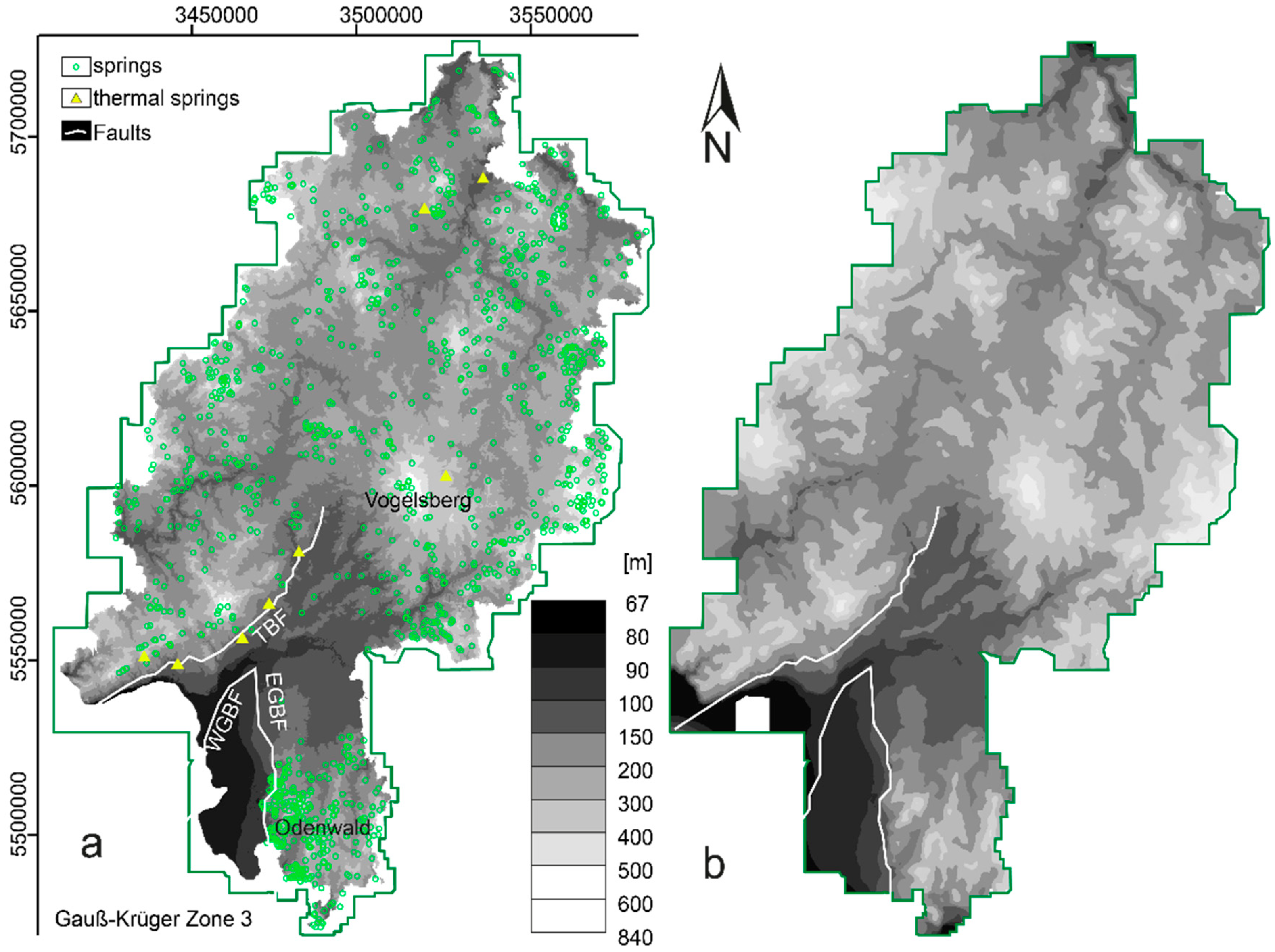
Appendix B.2. Recharge Data
Appendix B.3. Hydrochemical Observations
Appendix C
References
- Clauser, C. Conductive and Convective Heat Flow Components in the Rheingraben and Implications for the Deep Permeability Distribution. In Hydrogeological Regimes and Their Subsurface Thermal Effects; Beck, A.E., Garven, G., Stegena, L., Eds.; American Geophysical Union: Washington, DC, USA, 1989; Volume 47, pp. 59–65. [Google Scholar]
- Clauser, C.; Villinger, H. Analysis of conductive and convective heat transfer in a sedimentary basin, demonstrated for the Rheingraben. Geophys. J. Int. 1990, 100, 393–414. [Google Scholar] [CrossRef]
- Pribnow, D.; Clauser, C. Heat and fluid flow at the Soultz hot dry rock system in the Rhine Graben. In Proceedings of the World Geothermal Congress 2000, Kyushu, Tohoku, Japan, 28 May–10 June 2000. [Google Scholar]
- Bächler, D.; Kohl, T.; Rybach, L. Impact of graben-parallel faults on hydrothermal convection––Rhine Graben case study. Phys. Chem. Earth 2003, 28, 431–441. [Google Scholar] [CrossRef]
- Baillieux, P.; Schill, E.; Abdelfettah, Y.; Dezayes, C. Possible natural fluid pathways from gravity pseudo-tomography in the geothermal fields of Northern Alsace (Upper Rhine Graben). Geotherm. Energy 2014, 2, 16. [Google Scholar] [CrossRef]
- Vidal, J.; Genter, A. Overview of naturally permeable fractured reservoirs in the central and southern Upper Rhine Graben: Insights from geothermal wells. Geothermics 2018, 74, 57–73. [Google Scholar] [CrossRef]
- Freymark, J.; Bott, J.; Cacace, M.; Ziegler, M.; Scheck-Wenderoth, M. Influence of the Main Border Faults on the 3D Hydraulic Field of the Central Upper Rhine Graben. Geofluids 2019, 2019, 21. [Google Scholar] [CrossRef]
- Freymark, J.; Sippel, J.; Scheck-Wenderoth, M.; Bär, K.; Stiller, M.; Fritsche, J.-G.; Kracht, M. The deep thermal field of the Upper Rhine Graben. Tectonophysics 2017, 694 (Suppl. C), 114–129. [Google Scholar] [CrossRef]
- Bär, K.; Arndt, D.; Fritsche, J.-G.; Götz, A.E.; Kracht, M.; Hoppe, A.; Sass, I. 3D-Modellierung der tiefengeothermischen Potenziale von Hessen—Eingangsdaten und Potenzialausweisung. [3D modelling of the deep geothermal potential of the Federal State of Hesse (Germany)—Input data and identification of potential]. Z. Dtsch. Ges. Geowiss. 2011, 162, 371–388. [Google Scholar] [CrossRef]
- Aretz, A.; Bär, K.; Götz, A.; Sass, I. Outcrop analogue study of Permocarboniferous geothermal sandstone reservoir formations (northern Upper Rhine Graben, Germany): Impact of mineral content, depositional environment and diagenesis on petrophysical properties. Int. J. Earth Sci. 2016, 105, 1431–1452. [Google Scholar] [CrossRef]
- Schilling, O.; Sheldon, H.A.; Reid, L.B.; Corbel, S. Hydrothermal models of the Perth metropolitan area, Western Australia: Implications for geothermal energy. Hydrogeol. J. 2013, 21, 605–621. [Google Scholar] [CrossRef]
- Simms, M.A.; Garven, G. Thermal convection in faulted extensional sedimentary basins: Theoretical results from finite-element modeling. Geofluids 2004, 4, 109–130. [Google Scholar] [CrossRef]
- Lampe, C.; Person, M. Advective cooling within sedimentary rift basins—Application to the Upper Rhinegraben (Germany). Mar. Pet. Geol. 2002, 19, 361–375. [Google Scholar] [CrossRef]
- Rühaak, W.; Rath, V.; Clauser, C. Detecting thermal anomalies within the Molasse Basin, southern Germany. Hydrogeol. J. 2010, 18, 1897–1915. [Google Scholar] [CrossRef]
- Cherubini, Y.; Cacace, M.; Scheck-Wenderoth, M.; Noack, V. Influence of major fault zones on 3-D coupled fluid and heat transport for the Brandenburg region (NE German Basin). Geotherm. Energy Sci. 2014, 2, 1–20. [Google Scholar] [CrossRef]
- Kraml, M.; Jodocy, M.; Reinecker, J.; Leible, D.; Freundt, F.; Al Najem, S.; Schmidt, G.; Aeschbach, W.; Isenbeck-Schröter, M. TRACE: Detection of Permeable Deep-Reaching Fault Zone Sections in the Upper Rhine Graben, Germany, During Low-Budget Isotope-Geochemical Surface Exploration. In Proceedings of the European Geothermal Congress 2016, Strasbourg, France, 19–24 September 2016. [Google Scholar]
- Person, M.; Raffensperger, J.P.; Ge, S.; Garven, G. Basin-scale hydrogeologic modeling. Rev. Geophys. 1996, 34, 61–87. [Google Scholar] [CrossRef]
- Herrmann, F. Entwicklung einer Methodik zur Großräumigen Modellierung von Grundwasserdruckflächen am Beispiel der Grundwasserleiter des Bundeslandes Hessen; Brandenburgische Technische Universität Cottbus: Cottbus, Germany, 2010. [Google Scholar]
- Freymark, J.; Sippel, J.; Scheck-Wenderoth, M.; Bär, K.; Stiller, M.; Kracht, M.; Fritsche, J.-G. Heterogeneous Crystalline Crust Controls the Shallow Thermal Field—A Case Study of Hessen (Germany). Energy Procedia 2015, 76, 331–340. [Google Scholar] [CrossRef]
- Arndt, D. Geologische Strukturmodellierung von Hessen zur Bestimmung von Geopotenzialen. Ph.D. Thesis, TU Darmstadt, Darmstadt, Germany, 2012. [Google Scholar]
- Bär, K. Untersuchung der Tiefengeothermischen Potenziale von Hessen. Ph.D. Thesis, TU Darmstadt, Darmstadt, Germany, 2012. [Google Scholar]
- Sass, I.; Hoppe, A.; Arndt, D.; Bär, K. Forschungs-und Entwicklungsprojekt 3D Modell der Geothermischen Tiefenpotenziale von Hessen. Available online: https//www.energieland.hessen.de/pdf/3-D-Modell-Hessen-Endbericht_(PDF,_7.300_KB).pdf (accessed on 2 July 2013).
- Rühaak, W.; Bär, K.; Sass, I. Combining Numerical Modeling with Geostatistical Interpolation for an Improved Reservoir Exploration. Energy Procedia 2014, 59, 315–322. [Google Scholar] [CrossRef]
- Paul, J. Oolithe und Stromatolithen im Unteren Buntsandstein. In Trias—Eine Ganz Andere Welt, Mitteleuropa im Frühen Erdmittelalter; Hauschke, N., Wilde, V., Eds.; Dr. Friedrich Pfeil Verlag: München, Germany, 1999; pp. 263–270. [Google Scholar]
- Berger, J.-P.; Reichenbacher, B.; Becker, D.; Grimm, M.; Grimm, K.; Picot, L.; Storni, A.; Pirkenseer, C.; Derer, C.; Schaefer, A. Paleogeography of the Upper Rhine Graben (URG) and the Swiss Molasse Basin (SMB) from Eocene to Pliocene. Int. J. Earth Sci. 2005, 94, 697–710. [Google Scholar] [CrossRef]
- Berger, J.-P.; Reichenbacher, B.; Becker, D.; Grimm, M.; Grimm, K.; Picot, L.; Storni, A.; Pirkenseer, C.; Schaefer, A. Eocene-Pliocene time scale and stratigraphy of the Upper Rhine Graben (URG) and the Swiss Molasse Basin (SMB). Int. J. Earth Sci. 2005, 94, 711–731. [Google Scholar] [CrossRef]
- Murawski, H.; Albers, H.J.; Bender, P.; Berners, H.-P.; Dürr, S.; Huckriede, R.; Kauffmann, G.; Kowalczyk, G.; Meiburg, P.; Müller, R.; et al. Regional Tectonic Setting and Geological Structure of the Rhenish Massif. In Plateau Uplift; Fuchs, K., von Gehlen, K., Mälzer, H., Murawski, H., Semmel, A., Eds.; Springer: Berlin/Heidelberg, Germany, 1983; pp. 9–38. [Google Scholar]
- Bogaard, P.J.F.; Wörner, G. Petrogenesis of Basanitic to Tholeiitic Volcanic Rocks from the Miocene Vogelsberg, Central Germany. J. Petrol. 2003, 44, 569–602. [Google Scholar] [CrossRef]
- Jung, S. The Role of Crustal Contamination During the Evolution of Continental Rift-Related Basalts: A Case Study from the Vogelsberg Area (Central Germany). GeoLines 1999, 9, 48–58. [Google Scholar]
- Sherwood, G.J. A paleomagnetic and rock magnetic study of Tertiary volcanics from the Vogelsberg (Germany). Phys. Earth Planet. Int. 1990, 62, 32–45. [Google Scholar] [CrossRef]
- Dèzes, P.; Schmid, S.M.; Ziegler, P.A. Evolution of the European Cenozoic Rift System: Interaction of the Alpine and Pyrenean orogens with their foreland lithosphere. Tectonophysics 2004, 389, 1–33. [Google Scholar] [CrossRef]
- Arndt, D.; Bär, K.; Fritsche, J.-G.; Kracht, M.; Sass, I.; Hoppe, A. 3D structural model of the Federal State of Hesse (Germany) for geopotential evaluation. [Geologisches 3D-Modell von Hessen zur Bestimmung von Geo-Potenzialen.]. Z. Dtsch. Ges. Geowiss. 2011, 162, 353–369. [Google Scholar] [CrossRef]
- Paradigm. GOCAD 2009.1 User Guide Part IV Foundation Modeling; Paradigm Holding LLC: Nashville, TN, USA, 2009. [Google Scholar]
- HLUG. Geologische Übersichtskarte von Hessen 1:300 000. In 5. Überarbeitete Digitale Ausgabe; HLUG: Wiesbaden, Germany, 2007. [Google Scholar]
- Zitzmann, A. Tektonische Karte der Bundesrepublik Deutschland 1:1.000.000; BGR: Hannover, Germany, 1981. [Google Scholar]
- Anderle, H.J. Block Tectonic Interrelations between Northern Upper Rhine Graben and Southern Taunus Mountains. In Approaches to Taphrogenesis; Schweizerbart: Stuttgart, Germany, 1974; pp. 243–253. [Google Scholar]
- Derer, C.E. Tectono-Sedimentary Evolution of the Northern Upper Rhine Graben (Germany), with Special Regard to the Early Syn-Rift Stage. Ph.D. Thesis, University Bonn, Bonn, Germany, 2003. [Google Scholar]
- Franke, W. The mid-European segment of the Variscides: Tectonostratigraphic units, terrane boundaries and plate tectonic evolution. Geol. Soc. Lond. Spec. Publ. 2000, 179, 35–61. [Google Scholar] [CrossRef]
- Kossmat, F. Gliederung des varistischen Gebirgsbaues. Abh. Sächsisches Geol. Landesamt 1927, 1, 39. [Google Scholar]
- Klügel, T. Geometrie und Kinematik einer variszischen Plattengrenze—Der Südrand des Rhenoherzynikums im Taunus. Geol. Abh. Hess. 1997, 101, 215. [Google Scholar]
- Stein, E. The geology of the Odenwald Crystalline Complex. Mineral. Petrol. 2001, 72, 7–28. [Google Scholar] [CrossRef]
- Agemar, T.; Alten, J.-A.; Ganz, B.; Kuder, J.; Kühne, K.; Schumacher, S.; Schulz, R. The Geothermal Information System for Germany—GeotIS. Z. Dtsch. Ges. Geowiss. 2014, 165, 129–144. [Google Scholar] [CrossRef]
- Agemar, T.; Schellschmidt, R.; Schulz, R. Subsurface temperature distribution in Germany. Geothermics 2012, 44, 65–77. [Google Scholar] [CrossRef]
- Agemar, T.; Schellschmidt, R.; Schulz, R. 3D-Modell der Untergrundtemperatur von Deutschland. In Proceedings of the Des Geothermiekongresses 2011 Bochum, Bochum, Germany, 15–17 November 2011. [Google Scholar]
- Friedland, G. 3D Modelling of Deep Fluid Flow in the Central Upper Rhine Graben with Respect to Hydraulic Boundary Conditions. Master’s Thesis, Freie Universität Berlin, Berlin, Germany, 2018, unpublished. [Google Scholar]
- Diersch, H.-J. FEFLOW—Finite Element Modeling of Flow, Mass and Heat Transport in Porous and Fractured Media, 1st ed.; Springer: Berlin/Heidelberg, Germany, 2014. [Google Scholar]
- Kaiser, B.O.; Cacace, M.; Scheck-Wenderoth, M. 3D coupled fluid and heat transport simulations of the Northeast German Basin and their sensitivity to the spatial discretization: Different sensitivities for different mechanisms of heat transport. Environ. Earth Sci. 2013, 70, 3643–3659. [Google Scholar] [CrossRef]
- Clauser, C.; Griesshaber, E.; Neugebauer, H.J. Decoupled thermal and mantle helium anomalies: Implications for the transport regime in continental rift zones. J. Geophys. Res. Solid Earth 2002, 107, 2269. [Google Scholar] [CrossRef]
- Stober, I.; Bucher, K. Hydraulic conductivity of fractured upper crust: Insights from hydraulic tests in boreholes and fluid-rock interaction in crystalline basement rocks. Geofluids 2015, 15, 161–178. [Google Scholar] [CrossRef]
- DWD. Available online: https://werdis.dwd.de (accessed on 2 July 2013).
- Cacace, M.; Kaiser, B.O.; Lewerenz, B.; Scheck-Wenderoth, M. Geothermal energy in sedimentary basins: What we can learn from regional numerical models. Chem. Erde Geochem. 2010, 70, 33–46. [Google Scholar] [CrossRef]
- Kaiser, B.O.; Cacace, M.; Scheck-Wenderoth, M.; Lewerenz, B. Characterization of main heat transport processes in the Northeast German Basin: Constraints from 3-D numerical models. Geochem. Geophys. Geosyst. 2011, 12. [Google Scholar] [CrossRef]
- Siemon, B.; Blum, R.; Pöschl, W.; Voß, W. Aeroelektromagnetische und gleichstromgeoelektrische Erkundung eines Salzwasservorkommens im Hessischen Ried. Geol. Jahrb. Hess. 2001, 128, 115–125. [Google Scholar]
- Kopp, B.; Baumeister, C.; Gudera, T.; Hergesell, M.; Kampf, J.; Morhard, A.; Neumann, J. Entwicklung von Bodenwasserhaushalt und Grundwasserneubildung in Baden-Württemberg, Bayern, Rheinland-Pfalz und Hessen von 1951 bis 2015. Hydrol. Wasserbewirtsch. 2018, 62, 62–76. [Google Scholar]
- Leßmann, B. Hydrochemische und isotopenhydrologische Untersuchungen an Grundwässern aus dem Vulkangebiet Vogelsberg. Grundwasser 2001, 6, 81–85. [Google Scholar] [CrossRef]
- Neumann, J.; Wycisk, P. Mittlere Jährliche Grundwasserneubildung; Bundesministerium für Umwelt, Naturschutz und Reaktorsicherheit: Bonn, Germany, 2003. [Google Scholar]
- Kraml, M.; Jodocy, M.; Grobe, R.; GmbH, G.E. Verbundprojekt TRACE—TiefenReservoir-Analyse Und Charakterisierung von Der Erdoberfläche: Teil 1: Bestimmung Chemischer Und Isotopischer Parameter von Fluiden Und Gasen Zur Fündigkeitsabschätzung Und Ihre Anwendbarkeit Auf Tiefengeothermie-Projekte: Schlussbericht Teilvorhaben A: GeoThermal Engineering GmbH: Laufzeit Des Vorhabens: 1.6.2012-31.5.2015. Technical report; GeoThermal Engineering GmbH (GeoT): Karlsruhe, Germany, 2015. [Google Scholar]
- Scheck-Wenderoth, M.; Koltzer, N.; Cacace, M.; Bott, J. Regional hydraulic model of the Upper Rhine Graben. Geophys. Res. Abstr. 2019, 21. EGU2019–19216. [Google Scholar]
- Morhard, A. Kurzbeschreibung des Modells GWN-BW Erweiterungen in Version 2.0. Stand 13.05.2009 (ergänzt: Mai 2011); GIT HydroS Consult GmbH: Freiburg im Breisgau, Germany, 2009. [Google Scholar]
- Loges, A.; Wagner, T.; Kirnbauer, T.; Göb, S.; Bau, M.; Berner, Z.; Markl, G. Source and origin of active and fossil thermal spring systems, northern Upper Rhine Graben, Germany. Appl. Geochem. 2012, 27, 1153–1169. [Google Scholar] [CrossRef]
- Stober, I.; Bucher, K. Hydraulic and hydrochemical properties of deep sedimentary reservoirs of the Upper Rhine Graben, Europe. Geofluids 2015, 15, 464–482. [Google Scholar] [CrossRef]
- Grimm, K.I. Stratigraphie von Deutschland IX—Tertiär, Teil 1: Oberrheingraben und Benachbarte Tertiärgebiete; Schweizerbart: Stuttgart, Germany, 2011; Volume 75, p. 461. [Google Scholar]
- Lotz, K. Einführung in Die Geologie des Landes Hessen; Hitzeroth: Marburg, Germany, 1995; p. 267. [Google Scholar]
- Jodocy, M.; Stober, I. Porositäten und Permeabilitäten im Oberrheingraben und Südwestdeutschen Molassebecken. Erdöl Erdgas Kohle 2011, 127, 20–27. [Google Scholar]
- GeORG-Projektteam. Geopotenziale des tieferen Untergrundes im Oberrheingraben, Fachlich-Technischer Abschlussbericht des INTERREG-Projekts GeORG, Teil 2: Geologische Ergebnisse und Nutzungsmöglichkeiten; EU-Projekt GeORG, 2013; p. 346. [Google Scholar]
- Clauser, C.; Koch, A.; Hartmann, A.; Jorand, R.; Mottaghy, D.C.; Pechnig, R.; Rath, V.; Wolf, A. Erstellung statistisch abgesicherter thermischer und hydraulischer Gesteinseigenschaften für den flachen und tiefen Untergrund in Deutschland: Phase 1—Westliche Molasse und nördlich angrenzendes Süddeutsches Schichtstufenland; Endbericht 01.01.2005–31.10.2006; RWTH: Aachen, Germany, 2007. [Google Scholar]
- Molenaar, N.; Felder, M.; Bär, K.; Götz, A.E. What classic greywacke (litharenite) can reveal about feldspar diagenesis: An example from Permian Rotliegend sandstone in Hessen, Germany. Sediment. Geol. 2015, 326, 79–93. [Google Scholar] [CrossRef]
- Lampe, C.; Person, M. Episodic hydrothermal fluid flow in the Upper Rhinegraben (Germany). J. Geochem. Explor. 2000, 69–70, 37–40. [Google Scholar] [CrossRef]
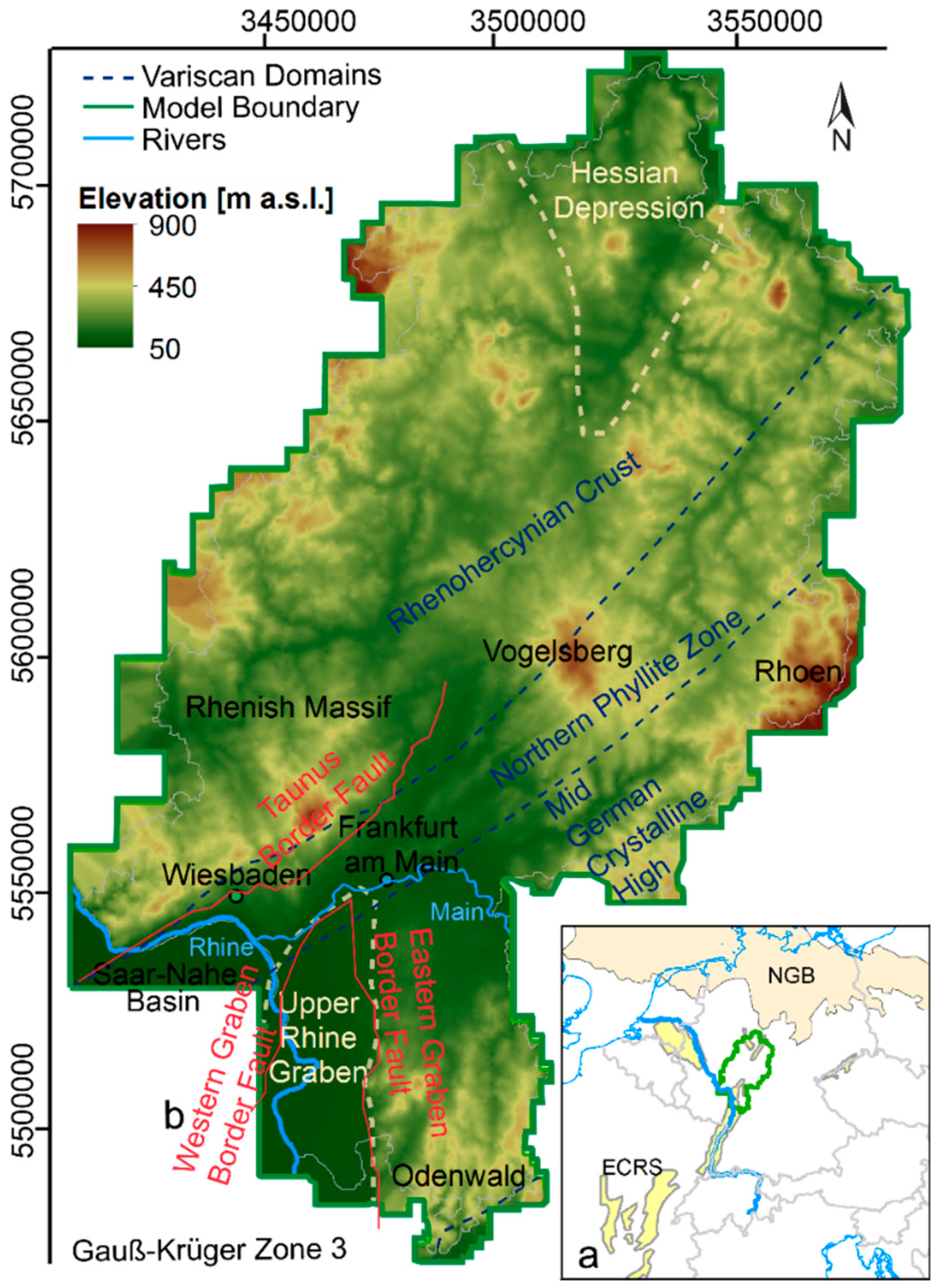

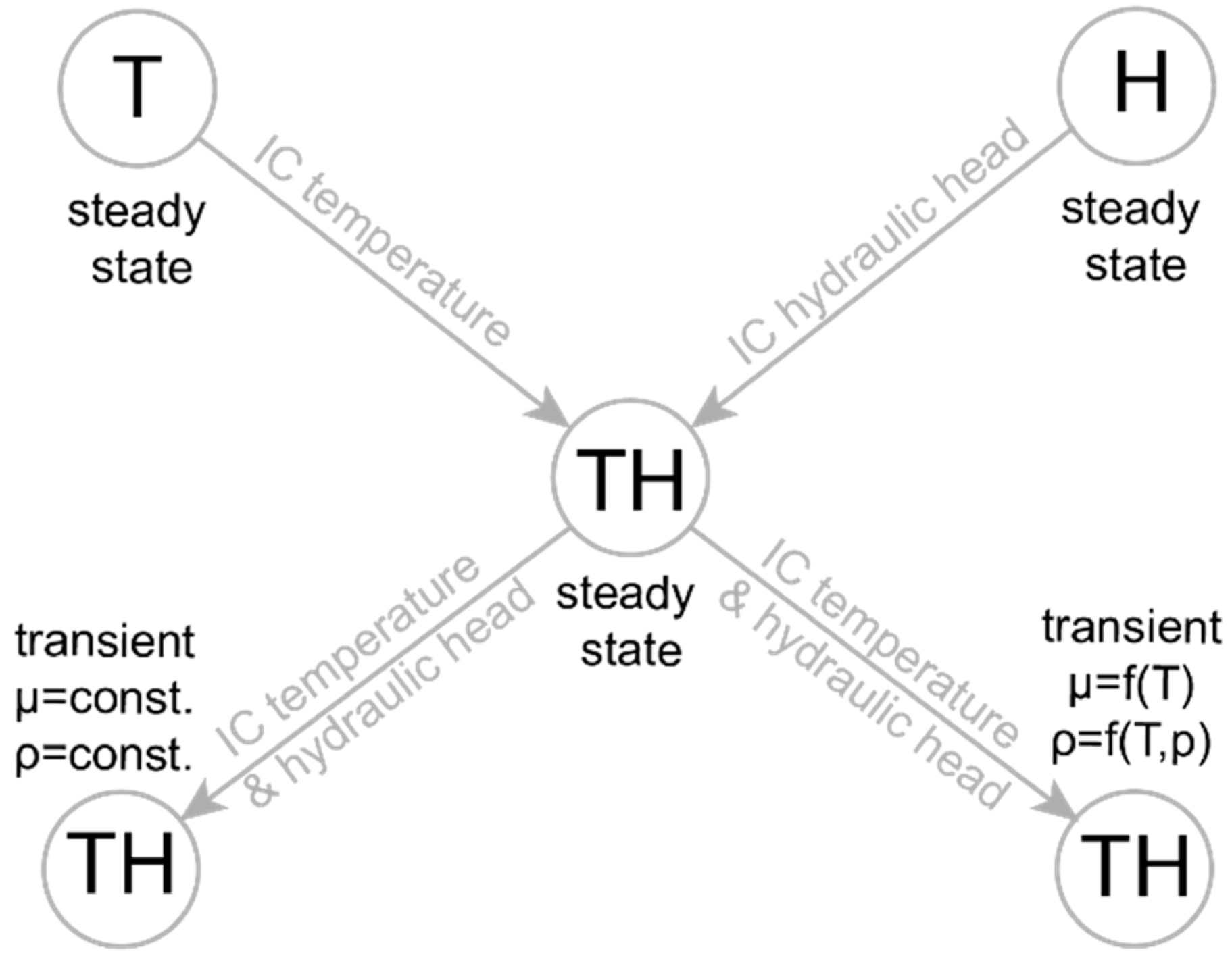
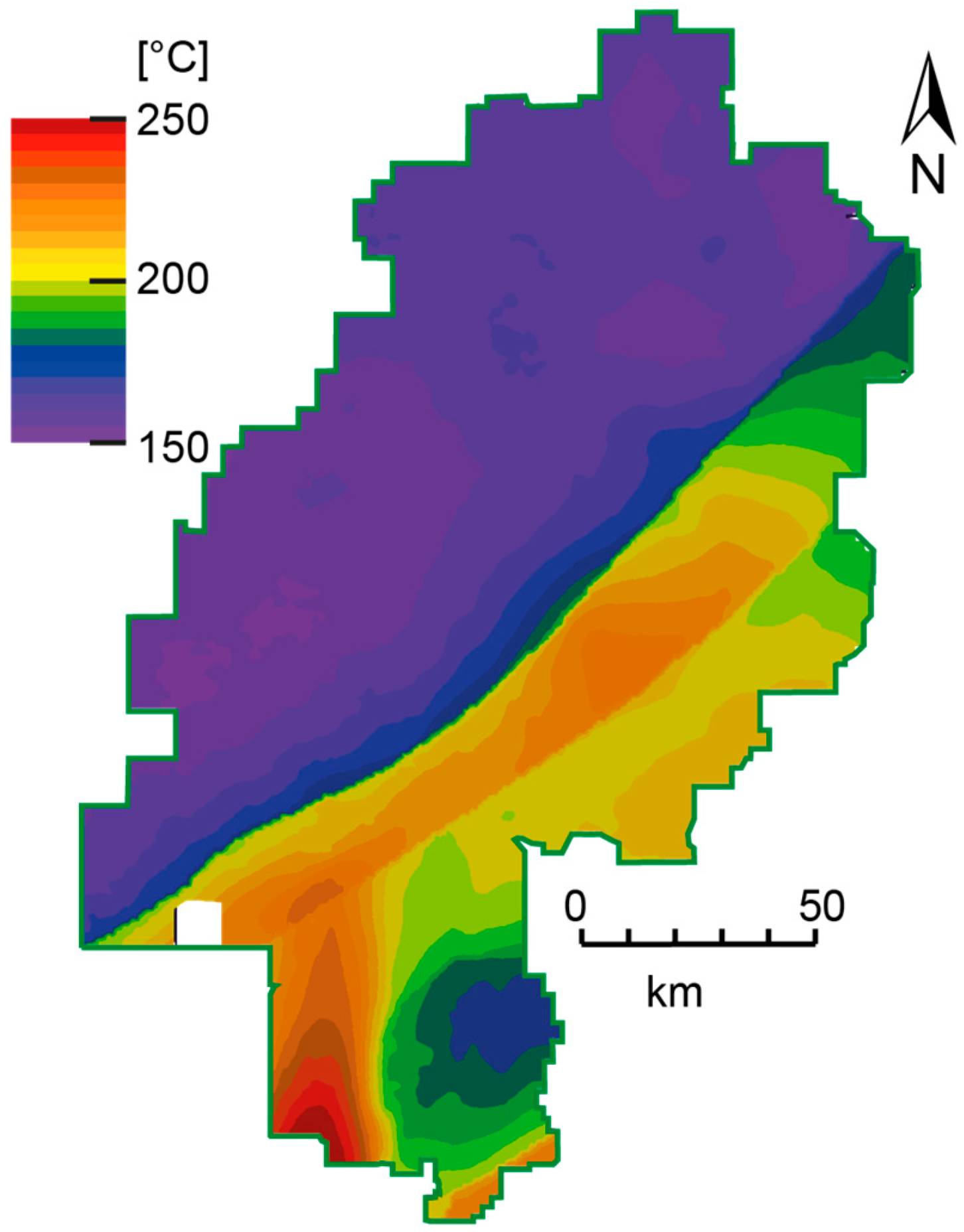
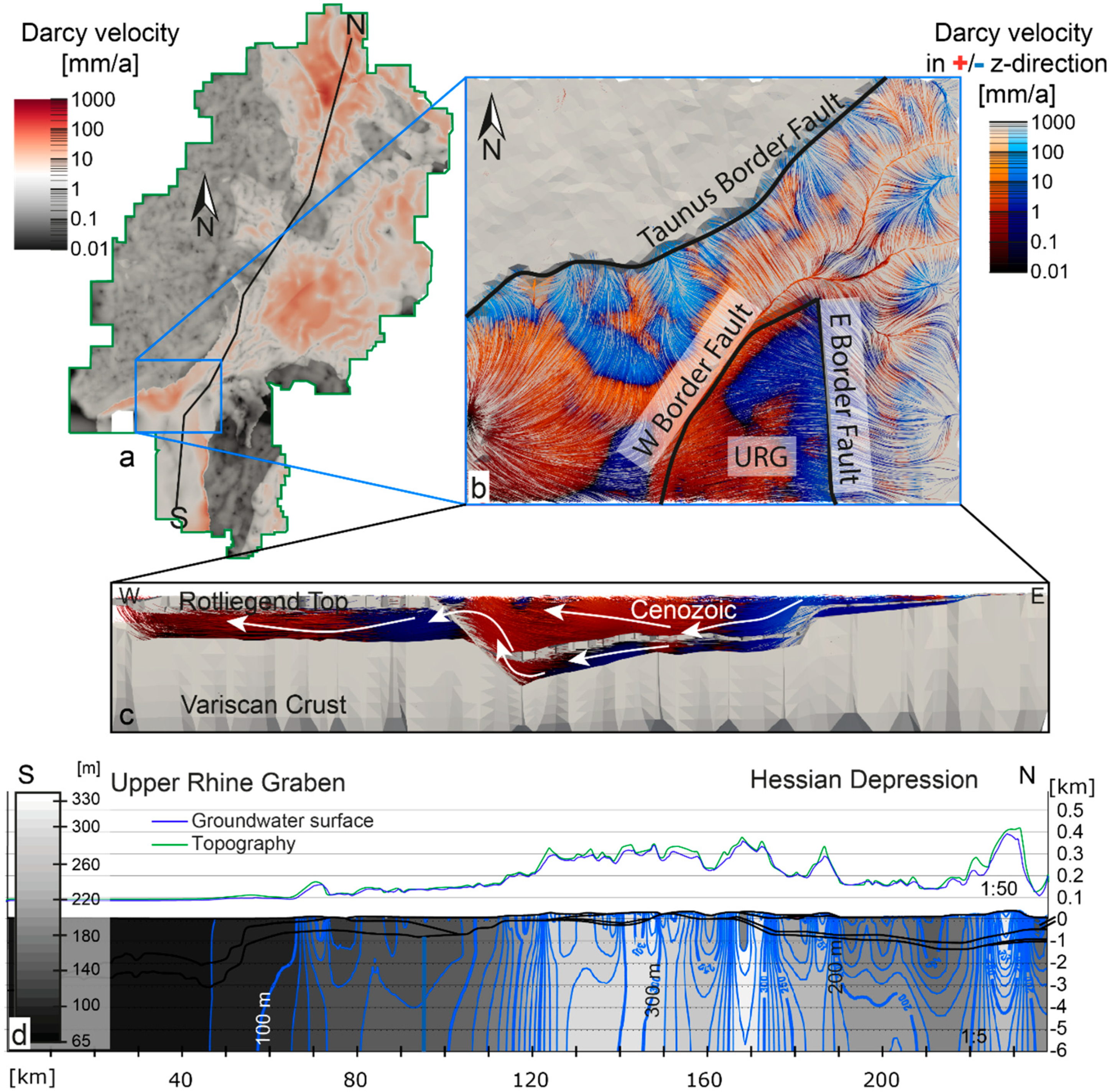
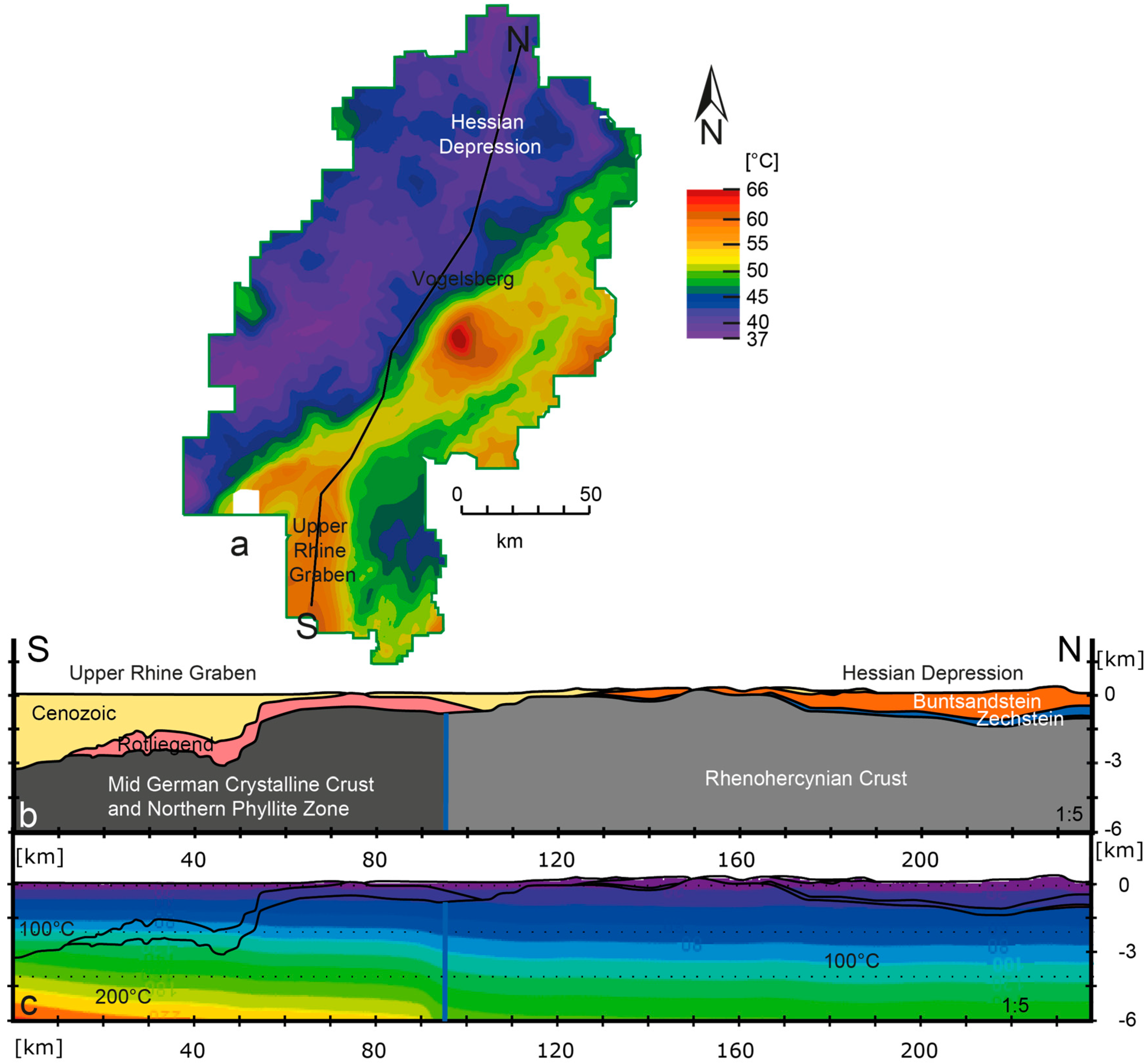
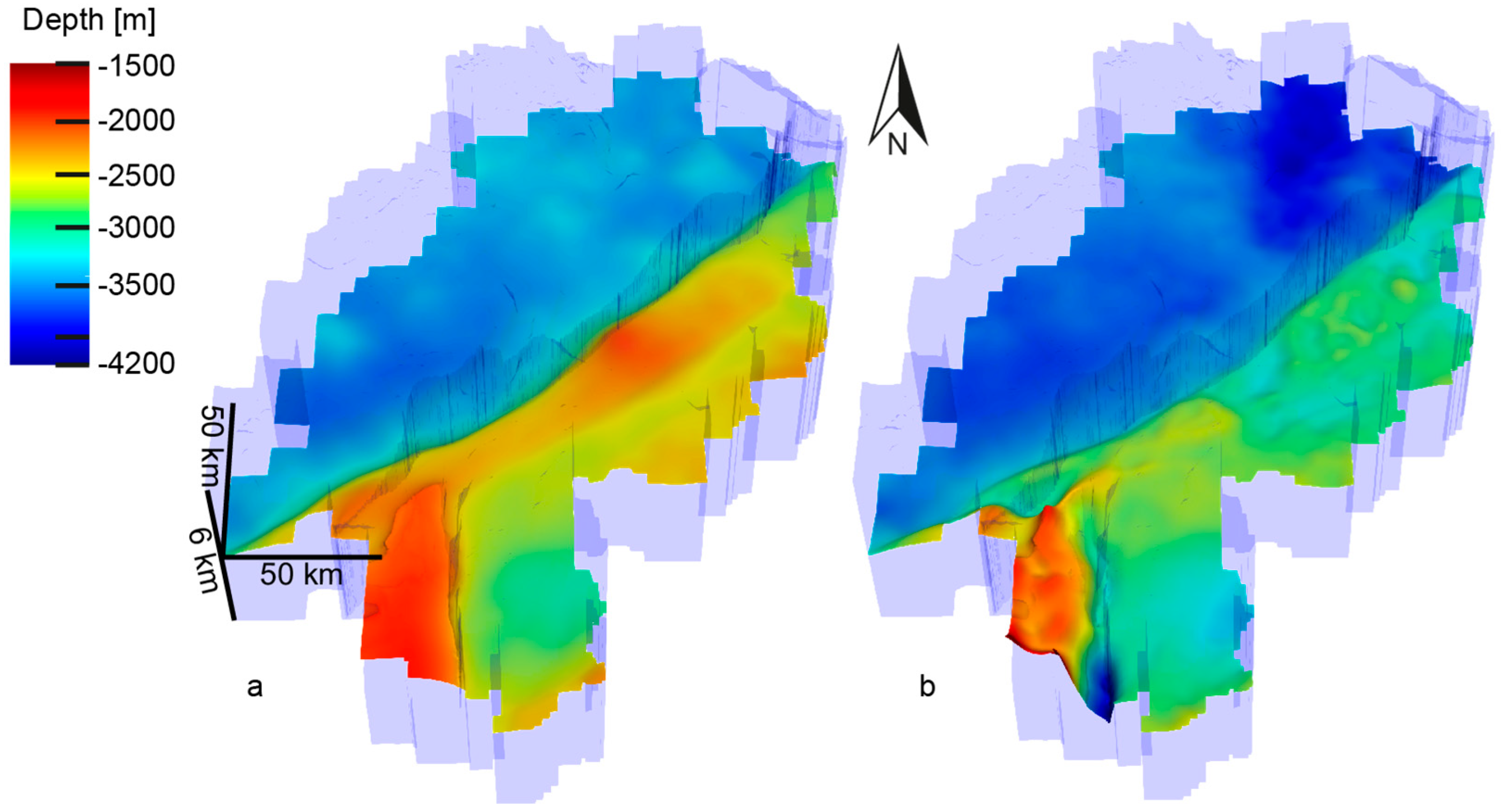
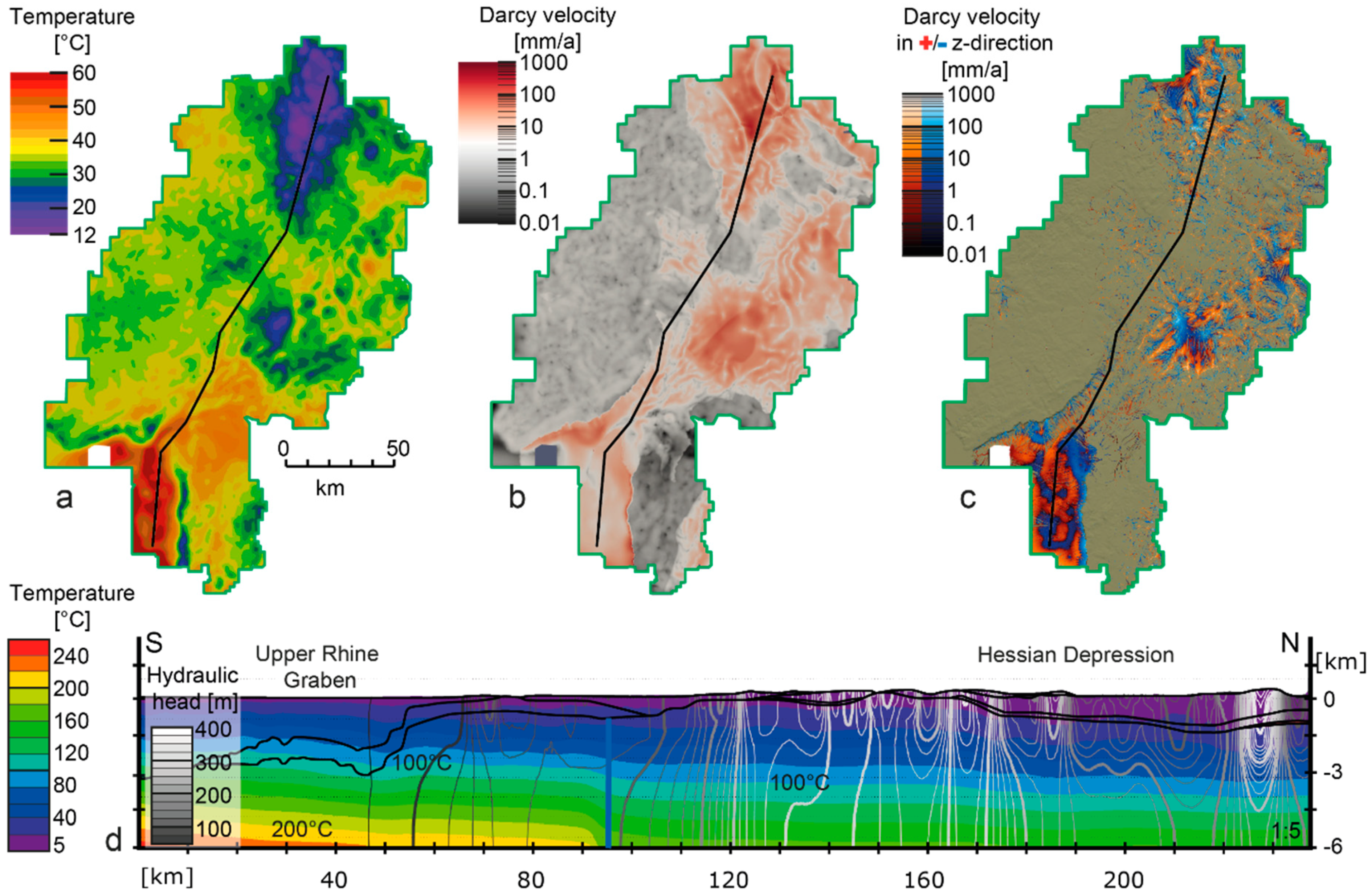
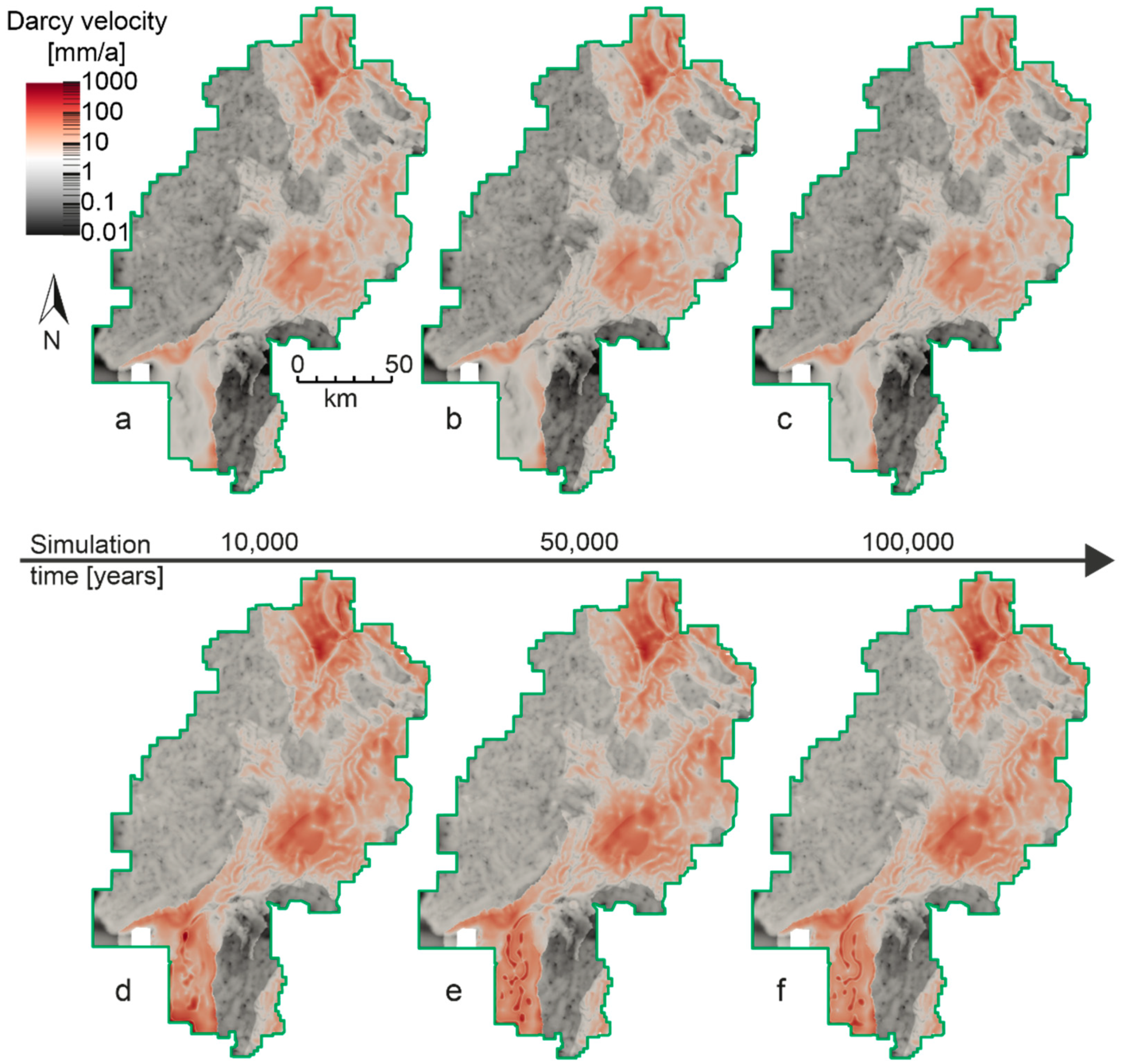
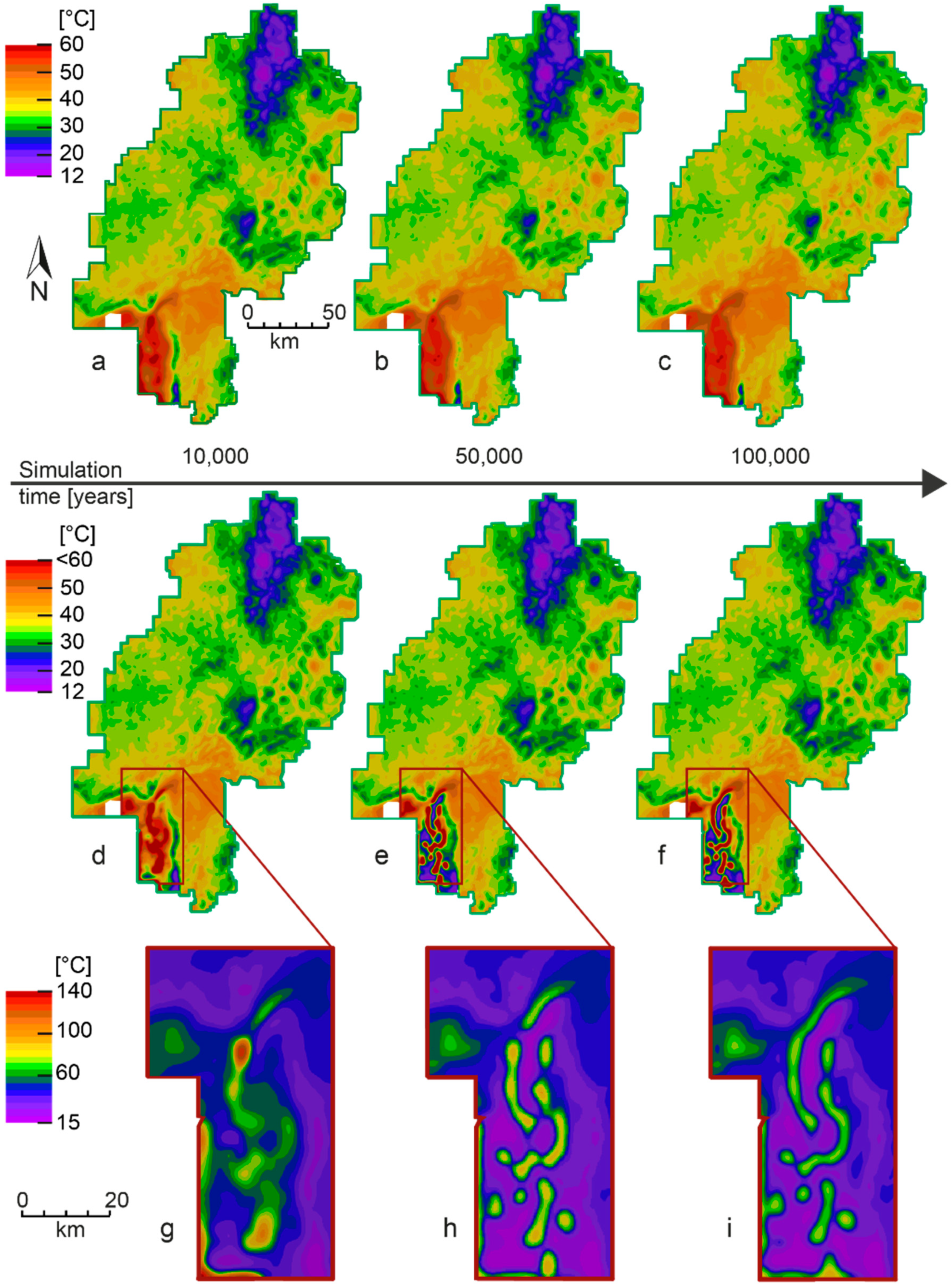
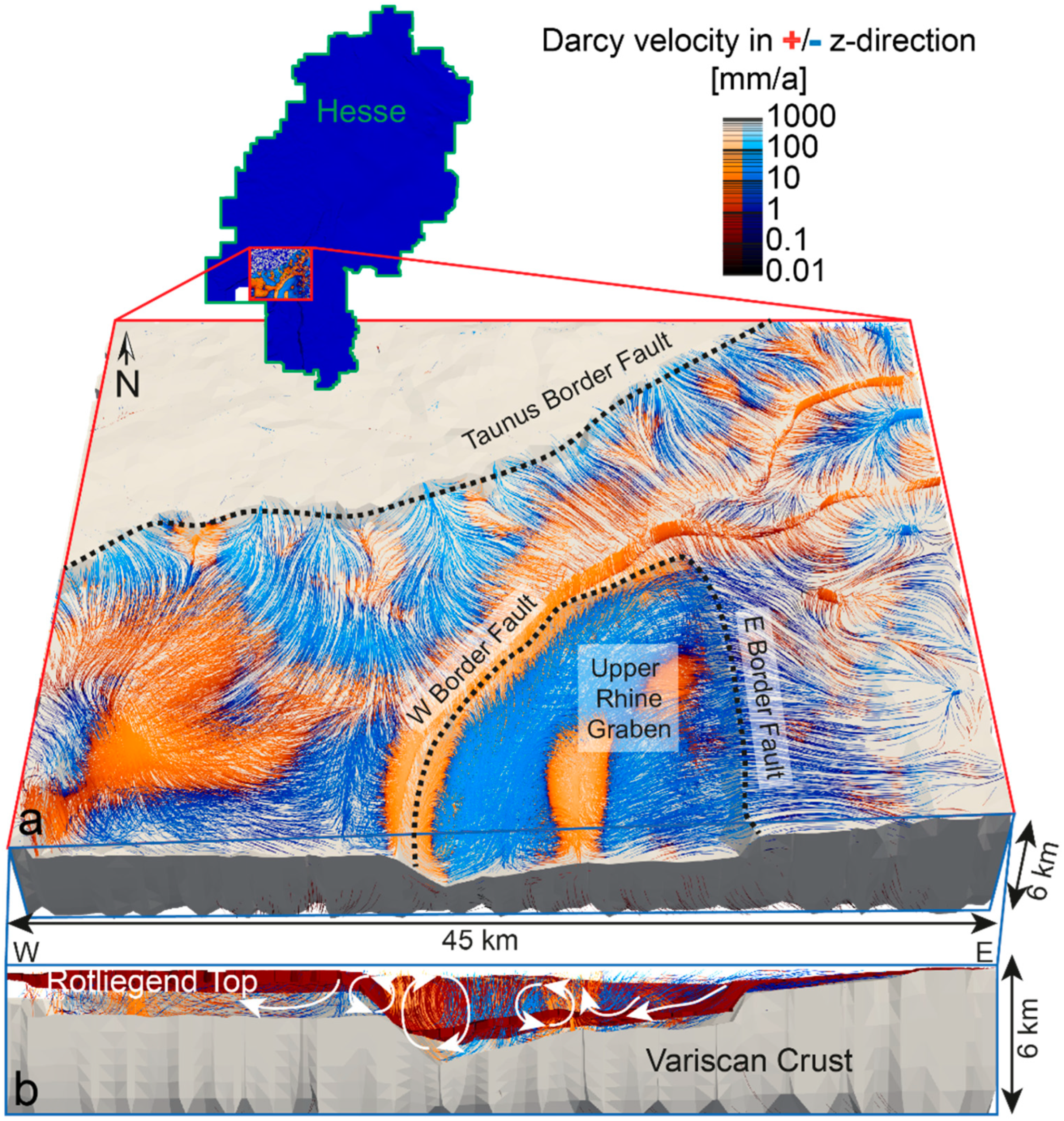
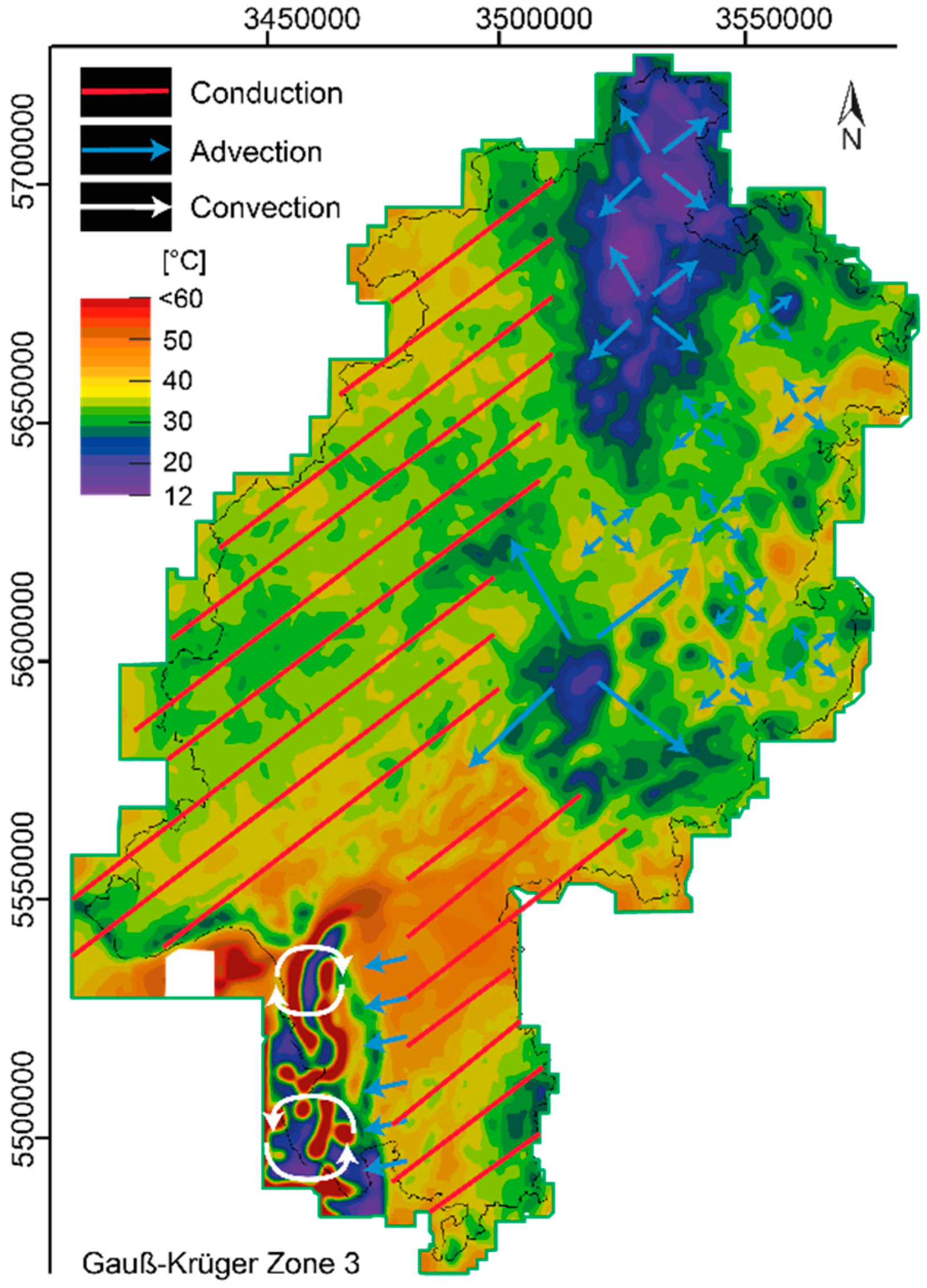
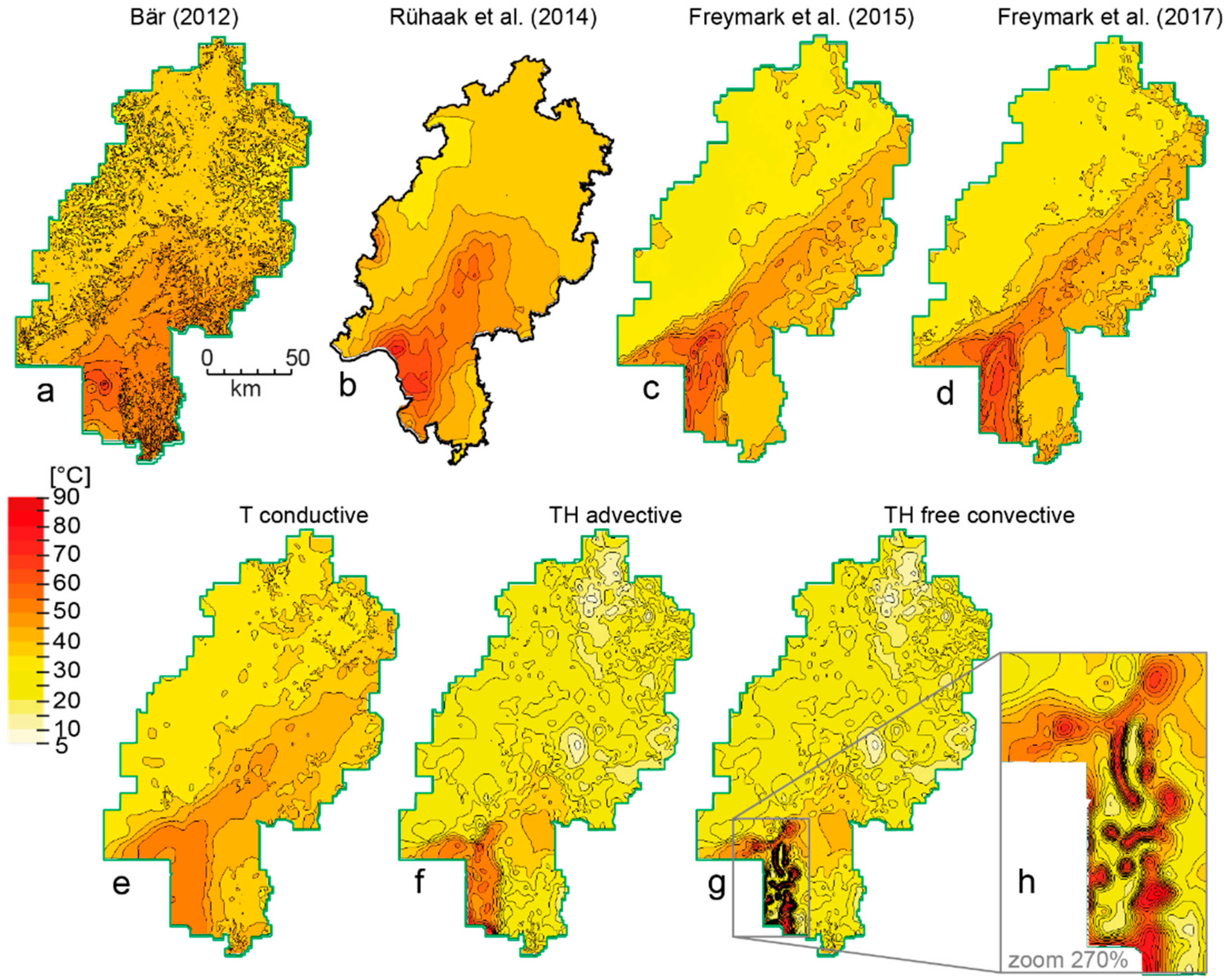
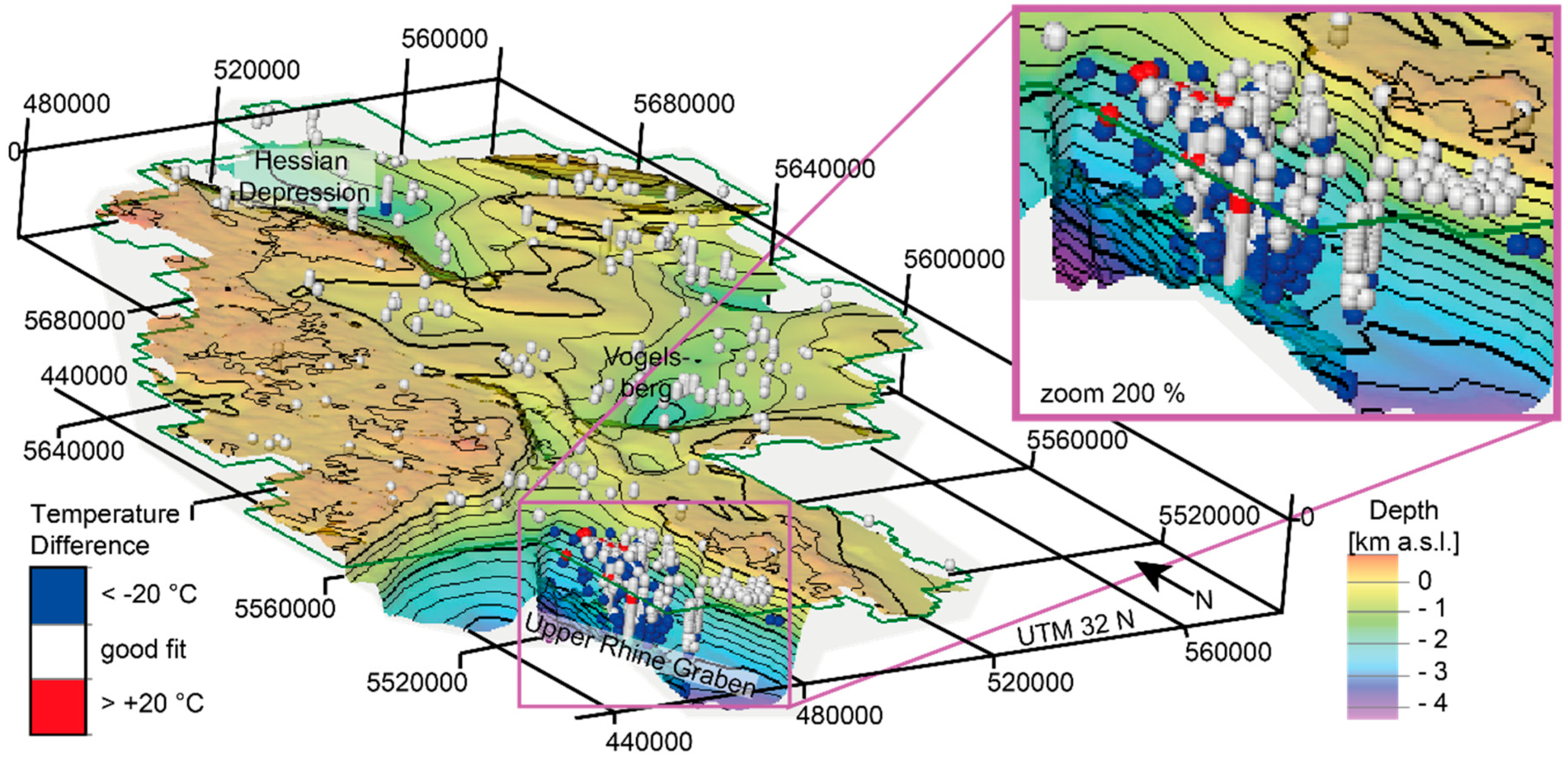
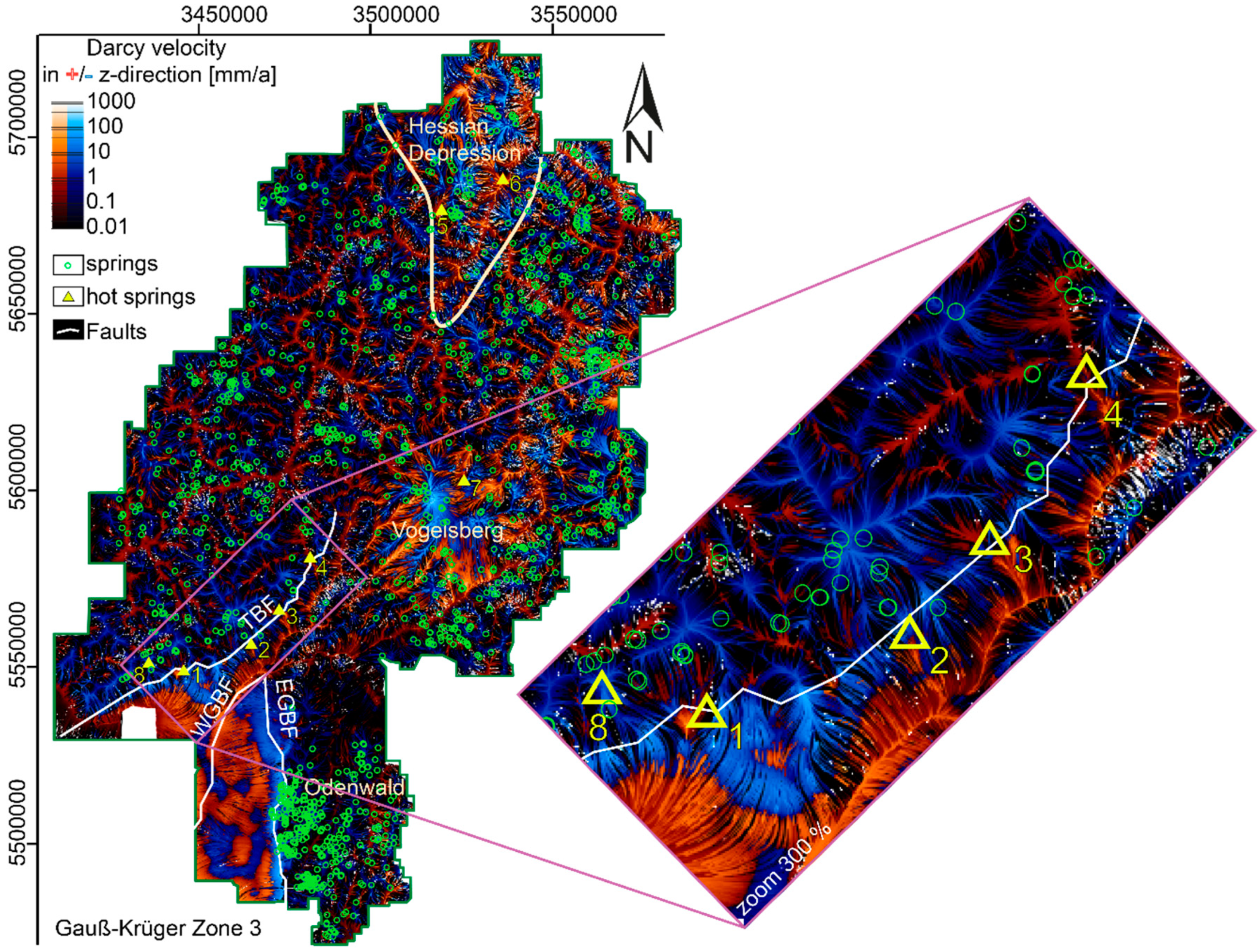
| Author | Arndt et al. [32], Bär [21], Arndt [20] | Rühaak et al. [23] | Freymark et al. [8,19] | Agemar et al. [42,43,44] |
|---|---|---|---|---|
| Method | Interpolation of measured temperatures in combination with Moho-depth related geothermal gradients | Combined geostochastic interpolation and conductive model to reach the best fit with measurements | Simulating physical processes of conductive heat transport in Hesse and the whole Upper Rhine Graben | Interpolation of measured temperatures of Germany’s sedimentary basins (Upper Rhine Graben in Hesse) |
| Model depth | 6 km depth | 6 km depth | lithosphere–asthenosphere boundary | variable depending on measurement depth |
| Numerical Layer | K [m/s] | n [-] | λ [W/m × K] | cs [MJ/m3K] | S [μW/m3] | Geological Unit |
|---|---|---|---|---|---|---|
| 1–6 | 1 × 10−7 (1),(4) | 0.02 (3) | 1.84 (3) | 2.0 (1) | 0.5 (2) | Quarternary/Tertiary |
| 7 | 5.7 × 10−10 (1) | 0.04 (3) | 2.1 (3) | 1.8 (1) | 1.2 (2) | Muschelkalk |
| 8, 9 | 1.9 × 10−7 (1) | 0.14 (3) | 2.97 (3) | 1.8 (1) | 1 (2) | Buntsandstein |
| 10, 11 | 5.5 × 10−9 (1) | 0.12 (3) | 2.55 (3) | 2.1 (1) | 0.8 (2) | Zechstein |
| 12–15 | 5.5 × 10−8 (1) | 0.09 (3) | 2.42 (3) | 2.0 (1) | 1 (2) | Rotliegend |
| 16 (6) | 1.4 × 10−9 (1) | 0.04 (3) | 2.81 (3) | 1.8 (1) | RH: 1 (2) NPZ: 3 (2) MGCH: 1.8 (2) | Upper Crust: RH |
| 17–21 | 7.9 × 10−12 (5) | |||||
| 16 (6) | 2.9 × 10−10 (1) | 0.002 (3) | 2.4 (3) | 2.1 (1) | Upper Crust: MGCH and NPZ | |
| 17–21 | 7.9 × 10−12 (5) |
© 2019 by the authors. Licensee MDPI, Basel, Switzerland. This article is an open access article distributed under the terms and conditions of the Creative Commons Attribution (CC BY) license (http://creativecommons.org/licenses/by/4.0/).
Share and Cite
Koltzer, N.; Scheck-Wenderoth, M.; Bott, J.; Cacace, M.; Frick, M.; Sass, I.; Fritsche, J.-G.; Bär, K. The Effects of Regional Fluid Flow on Deep Temperatures (Hesse, Germany). Energies 2019, 12, 2081. https://doi.org/10.3390/en12112081
Koltzer N, Scheck-Wenderoth M, Bott J, Cacace M, Frick M, Sass I, Fritsche J-G, Bär K. The Effects of Regional Fluid Flow on Deep Temperatures (Hesse, Germany). Energies. 2019; 12(11):2081. https://doi.org/10.3390/en12112081
Chicago/Turabian StyleKoltzer, Nora, Magdalena Scheck-Wenderoth, Judith Bott, Mauro Cacace, Maximilian Frick, Ingo Sass, Johann-Gerhard Fritsche, and Kristian Bär. 2019. "The Effects of Regional Fluid Flow on Deep Temperatures (Hesse, Germany)" Energies 12, no. 11: 2081. https://doi.org/10.3390/en12112081
APA StyleKoltzer, N., Scheck-Wenderoth, M., Bott, J., Cacace, M., Frick, M., Sass, I., Fritsche, J.-G., & Bär, K. (2019). The Effects of Regional Fluid Flow on Deep Temperatures (Hesse, Germany). Energies, 12(11), 2081. https://doi.org/10.3390/en12112081




